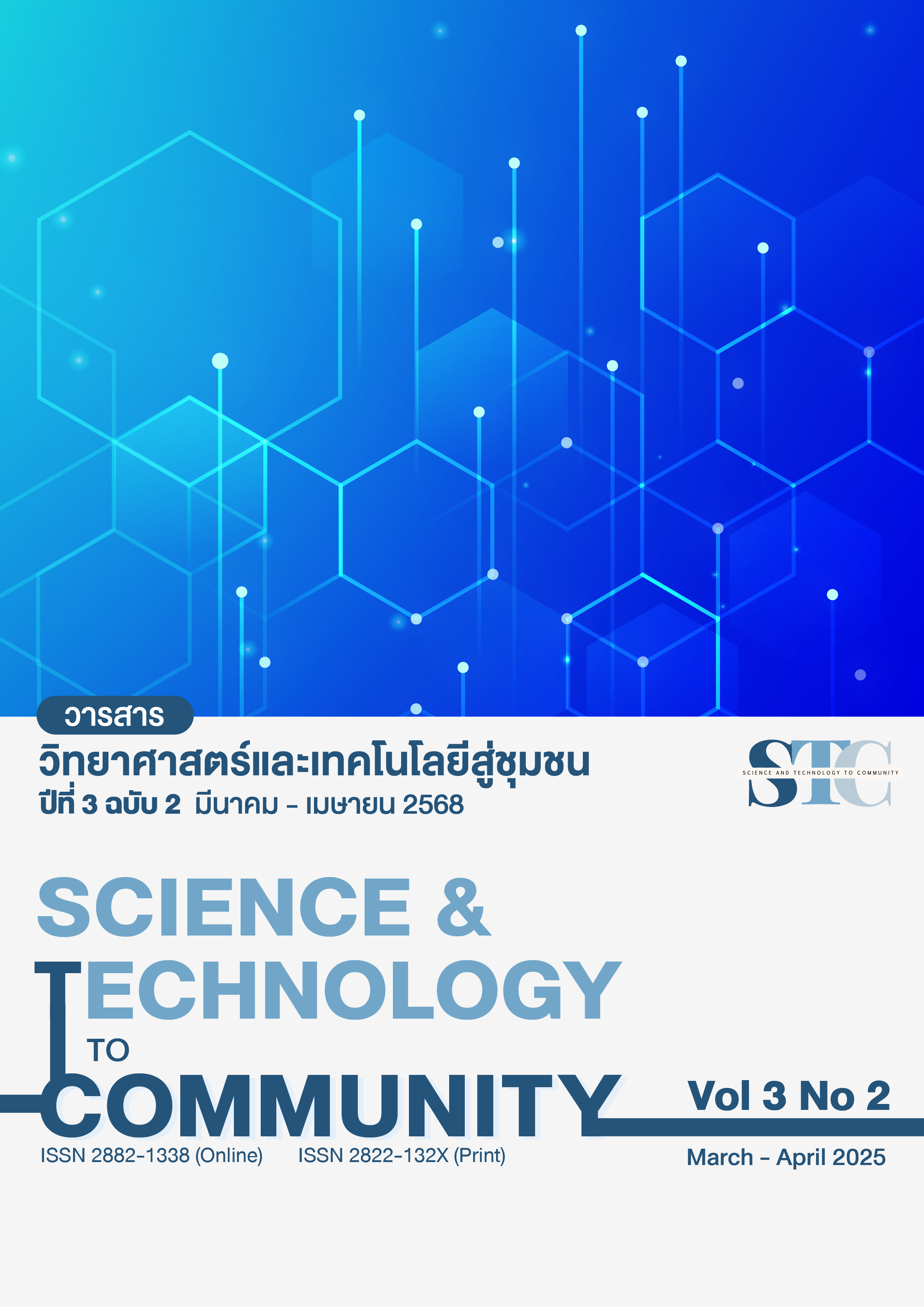The Optimal Conditions for the Molding Process of the Betel Nut Husk Container Forming Machine
DOI:
https://doi.org/10.57260/stc.2025.941Keywords:
Container forming, Betel nut husk, Mold movement time, Material thickness, Compression processAbstract
This research was to study a machine for forming containers from Betel nut husk, with the objective of create a container forming machine from Betel nut. Study the duration and distance of mold movement that affect compression. To study the time taken to form the container. To study the thickness of the betel nut husk that affects the shaping of the container. To study containers that help reduce plastic waste, the experiments were divided into 3 parts. The results of the experiments are as follows: Experiment 1 studied the duration and distance of the mold movement affecting compression. The duration was changed to 11, 12, 13, and 14 seconds, resulting in average mold distances of 6.87, 3.41, 1.70, and 0.85 centimeters, respectively, with stress values of 0.134, 0.190, 0.214, and 0.224 N/m². Experiment 2 studied the duration of container formation, with durations of 0, 30, 60, 90, and 120 seconds. It was found that at 120 seconds, the container shape was as desired, with slight distortion at the edges and minor bending. Experiment 3 studied the thickness of the Betel nut husk sheath affecting formation, with thicknesses of 0.5 – 0.9, 1.0 – 1.4, and 1.5 – 2.0 millimeters. It was found that a thickness of 1.5 – 2.0 millimeters maintained the desired shape. From the three experiments, the optimal conditions for the container forming machine were determined: the mold movement duration affecting compression was best at 14 seconds, the container formation duration was 120 seconds, and the Betel nut sheath thickness of 1.5 – 2.0 millimeters resulted in a beautifully shaped container ready for use.
Downloads
References
กิตติศักดิ์ เมืองกลาง, ณัฐพงษ์ รักด่านกลา, ณัฐวุฒิ ดงกระโทก, ทักษ์ดนัย จันทีนอก และ ธรรณธร ชิดการ เมืองกลาง. (2564). เครื่องขึ้นรูปภาชนะจากวัสดุธรรมชาติ. วารสารวิชาการเทคโนโลยีอุตสาหกรรม, 6(2), 65-76. สืบค้นจาก https://ph02.tci-thaijo.org/index.php/journalindus/article/view/245508
ไกรสร วงษ์ปู่ และ ปริดา จิ๋วปัญญา. (2564). การออกแบบและพัฒนาเครื่องขึ้นรูปภาชนะจากใบบัว. วารสารวิศวกรรมศาสตร์ มหาวิทยาลัยเทคโนโลยีราชมงคลล้านนา, 6(1), 19-27. สืบค้นจาก https://ph01.tci-thaijo.org/index.php/RMUTLEngJ/article/view/244627
จริญญา มีมุสิทธิ์, ศิริวรรณ ชูช่วย, จิระพงศ์ แก้วเจริญ และ เกษมสิทธิ์ ตั้งจรัสสุวรรณ. (2564). เครื่องขึ้นรูปภาชนะบรรจุอาหารภาชนะบรรจุภัณฑ์ธรรมชาติปลอดสารพิษ. วิทยานิพนธ์หลักสูตรวิศวกรรมการผลิต สาขาวิศวกรรมอุตสาหการ คณะวิศวกรรมศาสตร์ มหาวิทยาลัยเทคโนโลยีราชมงคลศรีวิชัย.
ณฐมน ทรัพย์บุญโต, รสริน จอห์นสัน, นพรัตน์ เตชะพันธ์รัตนกุล และ มงคลกร ศรีวิชัย. (2565). ปัจจัยส่วนประสมทางการตลาดที่ส่งผลต่อพฤติกรรมการเลือกซื้อภาชนะที่ผลิตจากวัสดุธรรมชาติของผู้บริโภคในจังหวัดเชียงราย. วารสารบริหารศาสตร์ มหาวิทยาลัยอุบลราชธานี, 11(2), 33-53. สืบค้นจาก https://so03.tci-thaijo.org/index.php/jms_ubu/article/view/256320
ดิสร พิณทอง, พิชัย สดภิบาล และ ทรงวุฒิ เอกวุฒิวงศา. (2560). การพัฒนาเครื่องอัดแผ่นจากวัสดุธรรมชาติ. วารสารวิชาการศิลปะสถาปัตยกรรมศาสตร์มหาวิทยาลัยนเรศวร, 8(1), 98-111. สืบค้นจาก https://so01.tci-thaijo.org/index.php/ajnu/article/view/91022
นากร เมียงอารมณ์ และ ธิติมา เกตุแก้ว. (2567). การพัฒนาเครื่องขึ้นรูปภาชนะบรรจุอาหารจากวัสดุธรรมชาติ. วารสารก้าวทันโลกวิทยาศาสตร์, 24(1), 181- 201. สืบค้นจาก https://li02.tci-thaijo.org/index.php/adscij/article/view/647
เพชรา บุดสีทา และ อําไพ แสงจันทร์ไทย. (2567). การพัฒนาและออกแบบผลิตภัณฑ์วัสดุธรรมชาติจากกาบกล้วย เพื่อเพิ่มรายได้ให้กับเกษตรกร จังหวัดกําแพงเพชร. วารสารสกวิทยาเพื่อการพัฒนา มหาวิทยาลัยราชภัฏอุตรดิตถ์, 14(2), 1-17. สืบค้นจาก https://so06.tci-thaijo.org/index.php/GRAURU/article/view/275484
ลัดดาวัลย์ จำปา, นัฐพงษ์ ทองปาน, นันทวัน หัตถมาศ, มลฤดี โอปมาวุฒิกุล, กัญญา ภัทรกุลอมร และ พรอารีย์ ศิริผลกุล. (2556). การถ่ายทอดเทคโนโลยีเครื่องขึ้นรูปภาชนะจากเยื่อเศษอ้อยในรูปแบบการจัดการความรู้เพื่อการเติบโตของชุมชนที่เป็นมิตรต่อสิ่งแวดล้อม. วารสารวิชาการมหาวิทยาลัยปทุมธานี, 15(2), 24-38. สืบค้นจาก https://so05.tci-thaijo.org/index.php/ptujournal/article/view/267736
วรพจน์ แซงบุญเรือง, ถนัดกิจ ศรีโชค, อัครวุฒิ เดือนเพ็ญ และ ชานนท์ แนวจำปา. (2565). การออกแบบการทดลองและพัฒนาสร้าง รูปแบบถ้วยจากผักตบชวา. วารสารเทคโนโลยีอุตสาหกรรม มหาวิทยาลัยราชภัฏอุบลราชธานี, 12(1), 53-66. สืบค้นจาก https://ph01.tci-thaijo.org/index.php/jitubru/article/view/243242
ศุภชัย หลักคำ และ พลรัชต์ บุญมี. (2562). การศึกษาความสามารถการรับความเค้นดัดของวัสดุผนังหนาและการดูดซับพลังงานของวัสดุสี่เหลี่ยมตันที่ผลิตจากวัสดุธรรมชาติ. วารสารวิจัยราชมงคลกรุงเทพ, 14(1), 40-51. สืบค้นจาก https://ph02.tci-thaijo.org/index.php/rmutk/article/view/221206
อังกาบ บุญสูง. (2566). การสร้างสรรค์ผลิตภัณฑ์ที่เป็นมิตรต่อสิ่งแวดล้อมจากฟางข้าวด้วยกระบวนการ BCG. วารสารดีไซน์เอคโค, 4(2), 2-16. สืบค้นจาก https://so02.tci-thaijo.org/index.php/jdecho/article/view/266436
Downloads
Published
How to Cite
Issue
Section
License
Copyright (c) 2025 Science and Technology to Community

This work is licensed under a Creative Commons Attribution-NonCommercial-NoDerivatives 4.0 International License.
1. Articles, information, content, images, etc. that are published in "Science and Technology for Community Journal" is the copyright of science and Technology for Community Journal. Chiang Mai Rajabhat University. If any person or organization wants to distribute all or any part of it or do any action Must have written permission from the science and Technology for Community Journal, Chiang Mai Rajabhat University.
2. Content of articles appearing in the journal is the responsibility of the author of the article. The journal editor is not required to agree or take any responsibility.














